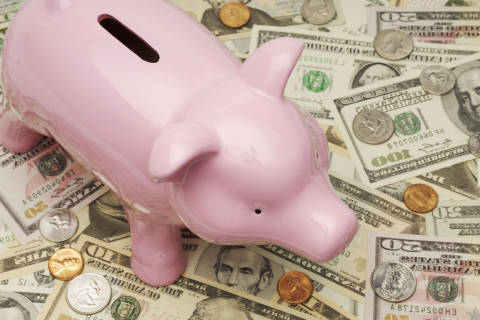
If you’re interested in saving money and killing off debt, you may want to try a “Frugal February” challenge.
The origins of this monthlong challenge are murky, but it’s been around for at least several years, gaining notoriety on personal finance blogs and social media.
What is a Frugal February challenge? The idea is that it’s a short month, and everybody’s burned out and broke from holiday shopping, so why not use February as a period to do something difficult but important — get your finances back on track?
If you’re thinking of trying a Frugal February challenge, here are some ideas:
— Track your expenses.
— Cut back on your energy costs.
— Go on a money diet.
— Audit your bills.
— Put more money in your savings.
[See: How to Give Back Without Breaking Your Budget.]
Track Your Expenses
This is a fairly painless financial exercise, but it may pay off in the long run, provided you build on what you learn.
“For the month of February, track your expenses, both cash and credit,” suggests Kyle Whipple, a partner at Custom Wealth Solutions, a financial planning firm in Plymouth, Michigan.
“Most people are shocked when they realize where their money is going,” he says. “Just like counting calories often makes you think twice about what you eat, when you see how your hard-earned money is being spent, it makes you think twice before you spend,” Whipple says.
While you’ll want to track all of your expenses to get the full picture, two important ones are:
— Groceries. You may be surprised by how much you’re spending at the grocery store if you haven’t been paying attention.
— Eating out. Americans typically eat out 5.9 times a week, according to the restaurant guide, Zagat. That adds up.
Cut Back on Your Energy Costs
Dawn-Marie Joseph, founder of Estate Planning & Preservation in Williamston, Michigan, says she has heard of frugal February — and approves.
“While many individuals may not be thrilled with the concept, it is a real thing and could actually help you cut down expenses and save more,” she says.
Joseph particularly likes the idea of cutting back on electric and gas costs. Two ideas:
— Limit the lights in your home. Make a concerted effort to turn off lights that aren’t being used. This might also be a good time to replace any conventional light bulbs with energy-saving LED ones.
— Turn down the thermostat. The U.S. Department of Energy estimates savings of about 1% on your energy bill when you lower your thermostat just one degree — assuming you keep it lowered for eight hours. Keep your thermostat lower by, say, five degrees, and you can see how that might help your bill.
“Wearing a sweater at home or cuddling under a blanket can actually save you money. After your December holiday electric bill, you’ll be happy to have a smaller bill in February,” Joseph says.
[See: How to Save Money When Grocery Shopping on a Budget.]
Go on a Money Diet
“For Frugal February, spend no money other than whatever’s absolutely necessary,” suggests Wendy Terrill, owner of Assurance & Guarantee, a financial consultancy in Graham, North Carolina.
For instance, you could spend less on:
— Food. “Challenge yourself to eat new things that are cheaper and can be purchased and made at home,” Terrill suggests, adding that you’ll really save a lot if you don’t eat out.
— Impulse shopping. Maybe tell yourself that you won’t make any sudden purchases over a certain dollar amount until you give yourself 24 hours to think about it. Not that you want to ignore important day-to-day items, but you do want to create a habit of mindful spending.
Of course, a money diet doesn’t mean you don’t spend anything. Nobody’s suggesting you don’t pay your mortgage or electric bill. But if you can skip going out to see a movie and instead watch something on a streaming service you’re already paying for, this is that month. If you don’t need to buy clothes in February, don’t. And impulse shopping in February can be eliminated entirely.
Audit Your Bills
You’ve tracked your spending. You’re cutting back and taking extra steps like lowering your energy costs. Now you might want to study what you’re actually still spending money on.
For instance, you might look at:
— Entertainment. “Do you have cable but only watch three channels?” Terrill asks. “Change your package.”
— Insurance. You’re paying for homeowners insurance, as you should, but have you looked at it lately? Maybe you bought a security system recently and haven’t asked about getting a discount? If you study your bills, you may find an easy way to save.
“Review your credit card and bank statements to see what automatic payments are taking place,” Whipple suggests. “Sometimes we sign up for a program and fail to use it or forget to cancel an introductory promotion. That’s money going out the door that you don’t even know about.”
But he also says you might find monthly payments for services that you aren’t using — but should. He says a gym membership, for instance, might be something you’re paying for. Instead of canceling it, you could start going. “This may kick-start a great new habit for 2020,” he says.
On the other hand, if you don’t cancel and it doesn’t kick-start a great new habit, you might find yourself during the Frugal February challenge of 2021 thinking, “Maybe I should finally cancel that gym membership.”
[See: How to Build an Emergency Fund.]
Put More Money in Your Savings
If you save money from auditing your bills, reducing spending and so on, Whipple then suggests taking that money that you were spending and diverting it into a savings or retirement account “since you’re already not used to seeing that money in your pocket.”
Consider putting your “extra” money toward:
— Retirement. Or finally start a retirement account if you haven’t yet.
— Your emergency fund. You have one, right? If not, this would be a good month to finally establish it.
Maybe for this month only, you double what you’re putting into your savings accounts. Or if that’s too much of an increase, put in an extra $50 or $100 or whatever makes sense. After all, there’s no need to create a financial emergency in March by putting too much money into your savings. But if you really want to take a frugal February challenge seriously, be ambitious.
That is, after all, what frugal February challenges are all about. You’re trying to push yourself to do better with your finances, because odds are, by March, you’ll have long forgotten about all of those “I’m not going to spend so much money” resolutions you made at the beginning of the year.
More from U.S. News
10 Expenses Destroying Your Budget
12 Useless Fees Draining Your Budget
9 Secrets to Save Money on a Shoestring Budget
How to Do a Frugal February Challenge originally appeared on usnews.com






